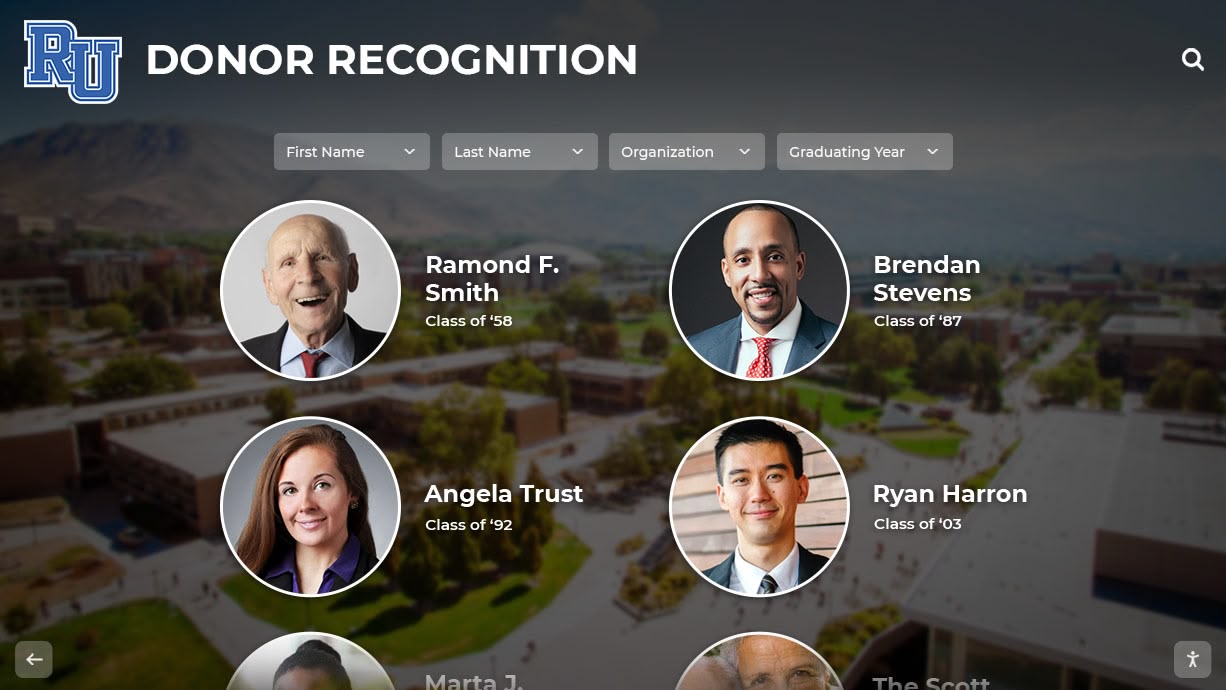Key Takeaways
Discover how colleges use digital donor recognition displays to increase donor engagement, improve retention rates, and drive fundraising success. Complete guide to modern donor recognition strategies for higher education advancement.
The Critical Connection Between Recognition and Donor Engagement
Donor recognition and donor engagement form an interconnected cycle that drives advancement success. Understanding this relationship helps colleges develop recognition strategies that deliver measurable results.
Why Donor Recognition Drives Engagement
Effective recognition satisfies fundamental psychological needs that influence giving behavior. When donors receive meaningful acknowledgment, several engagement mechanisms activate simultaneously.
Social Validation and Belonging
Donors who see their contributions publicly recognized experience social validation that strengthens their connection to institutions. Recognition demonstrates that their generosity matters to communities they care about, creating sense of belonging that extends beyond transactional relationships. According to advancement research, 90% of donors prefer experiential recognition over physical formats like letters or gifts, emphasizing the importance of experiences that make supporters feel valued and connected.
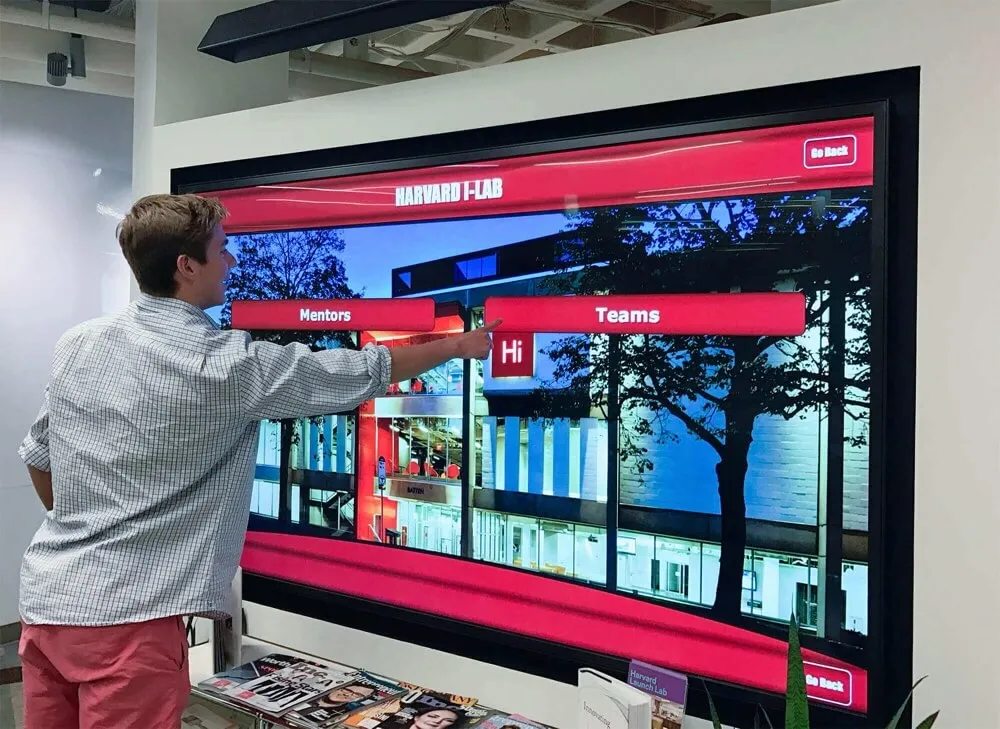
Aspiration and Peer Influence
Visible recognition creates aspiration effects where donors see giving levels above their current participation and stretch to reach higher recognition tiers. When colleges showcase community leaders, respected professionals, and peers at various giving levels, prospective donors see philanthropy as normal and desirable behavior worthy of emulation.
Ongoing Relationship Building
Unlike one-time thank you letters that fade from memory, permanent recognition provides ongoing touchpoints that reinforce donor relationships each time supporters visit campus or view online displays. This sustained visibility keeps institutions top-of-mind and strengthens emotional bonds over time.
The Cost of Poor Recognition
Conversely, inadequate recognition directly contributes to declining engagement and donor attrition that plague college advancement offices.
Donor Disengagement Factors
Research from advancement professionals identifies several ways poor recognition leads to disengagement:
- Donors feel their contributions go unnoticed and unappreciated
- Lack of communication about gift impact creates disconnection
- Generic, impersonal acknowledgment fails to create emotional resonance
- Delayed recognition diminishes timely appreciation impact
- Invisible stewardship suggests gifts don’t matter to institutions
- Missing updates about programs supported leave donors uninformed
When colleges fail to recognize donors meaningfully, supporters conclude their generosity doesn’t matter and redirect philanthropic investment to organizations providing better stewardship experiences.
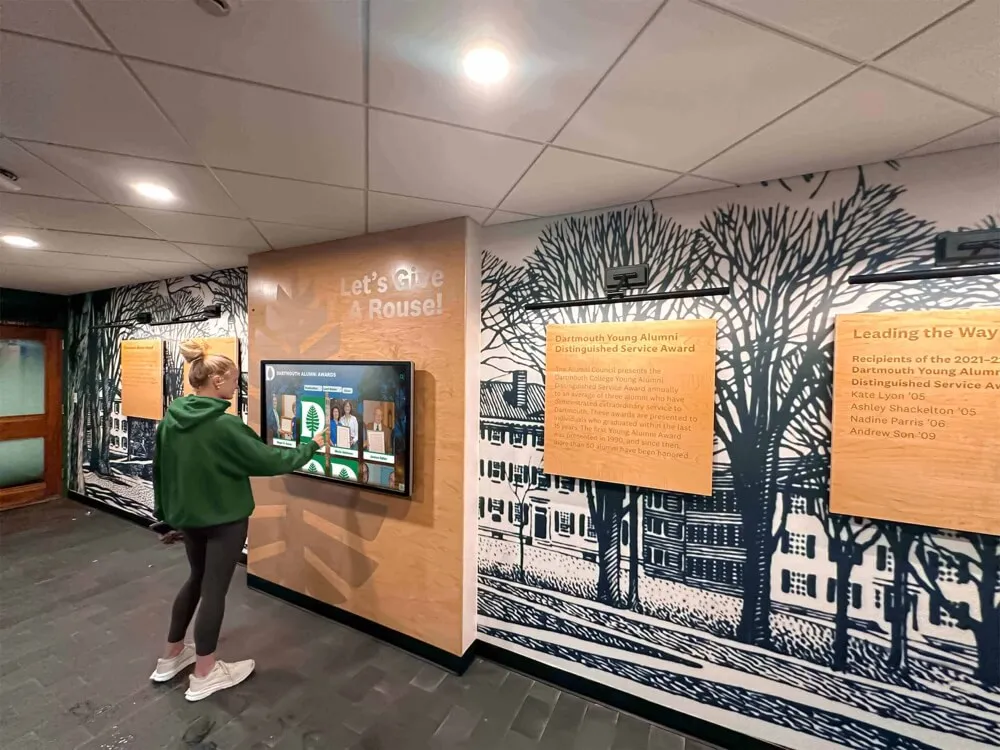
The Retention Challenge
Declining donor retention creates compounding problems for advancement offices. Acquiring new donors costs 5-7 times more than retaining existing supporters, meaning poor retention forces disproportionate resource allocation to acquisition rather than relationship deepening. As retention drops, development teams must run faster just to maintain previous fundraising levels, creating unsustainable workload pressures.
For comprehensive strategies on connecting with supporters, explore resources on best ways to connect with alumni.
How Digital Recognition Transforms College Donor Engagement
Modern digital recognition systems address fundamental limitations of traditional approaches while providing expanded capabilities that directly increase donor engagement and fundraising outcomes.
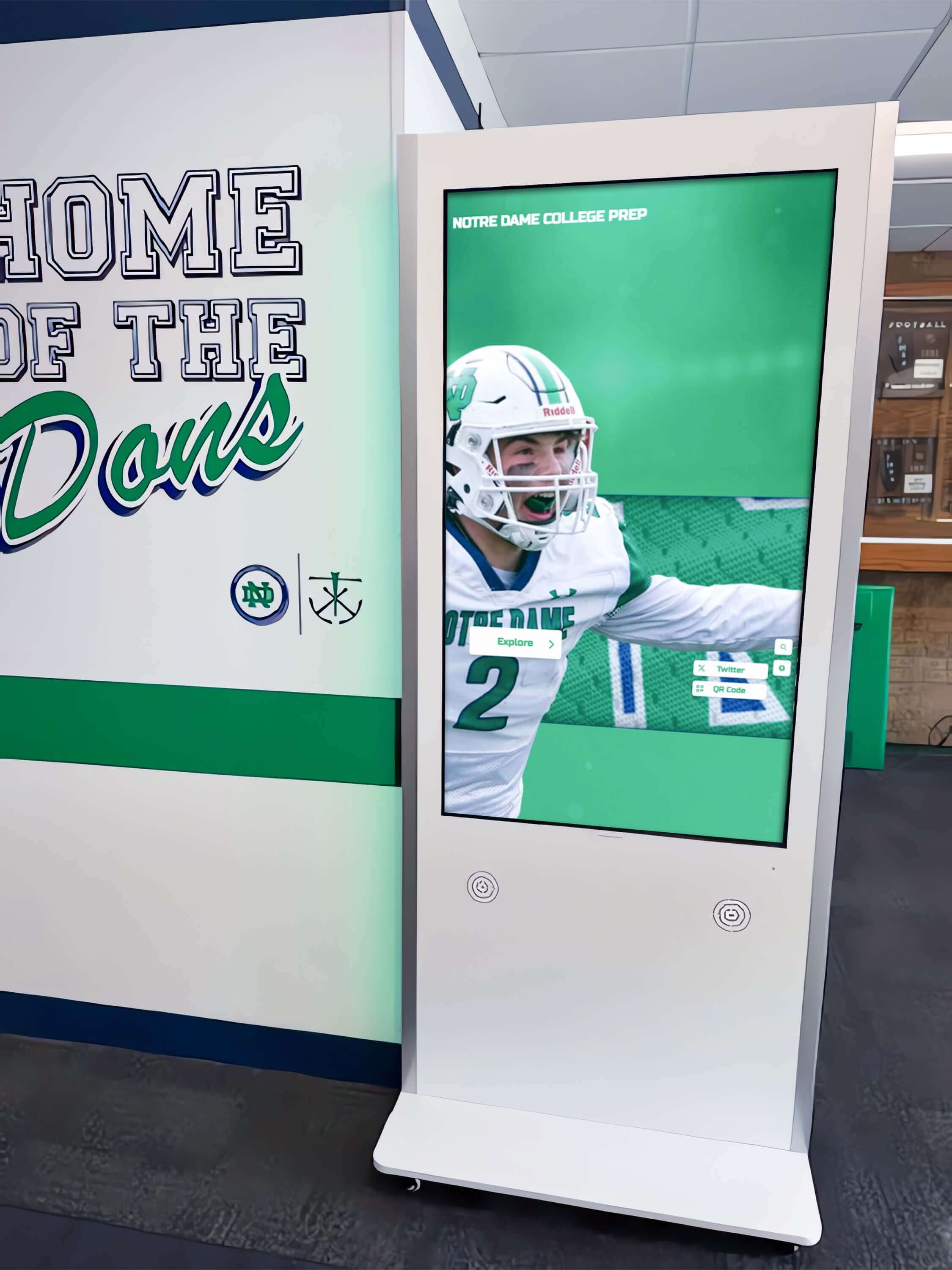
Unlimited Recognition Capacity Enables Inclusive Engagement
Traditional donor walls face inevitable space constraints that force difficult exclusions or expensive facility modifications. Digital displays eliminate these arbitrary limitations, enabling colleges to recognize every donor appropriately regardless of gift size.
Comprehensive Recognition Benefits
When colleges recognize donors at all giving levels, engagement benefits multiply across the donor pyramid:
- Annual fund donors who might never qualify for traditional plaque recognition receive meaningful acknowledgment that encourages continued support
- Mid-level donors see clear pathways to higher recognition tiers, motivating gift upgrades
- Major gift prospects observe comprehensive community support that validates their consideration of larger commitments
- First-time donors experience immediate recognition that creates positive first impressions
- Legacy society members receive ongoing visibility beyond initial planned gift documentation
This inclusive approach creates engagement touchpoints with donors who traditional recognition necessarily excludes, dramatically expanding the number of supporters receiving meaningful stewardship through recognition.
Flexible Recognition Structures
Solutions like Rocket Alumni Solutions enable advancement teams to create sophisticated recognition frameworks that serve strategic objectives. Colleges can simultaneously display:
- Lifetime cumulative giving societies with multiple tiers
- Annual giving recognition highlighting consistent supporters
- Campaign-specific donor acknowledgment for capital initiatives
- Scholarship endowment supporters funding student access
- Volunteer leadership recognition for non-financial contributions
- Special recognition categories for planned gifts and bequests
This structural flexibility allows advancement teams to design recognition programs aligned with fundraising strategy rather than compromising due to physical limitations.
Rich Storytelling Creates Emotional Connections
Traditional plaques convey minimal information—typically just names, graduation years, and giving levels. Digital recognition enables comprehensive storytelling that creates emotional resonance impossible with engraved metal.
Multimedia Donor Profiles
Digital displays can feature:
- Professional photographs creating personal connections
- Video testimonials where donors explain their motivations
- Written narratives sharing personal stories and institutional relationships
- Family legacy information for multi-generational supporters
- Impact statements demonstrating how specific gifts created change
- Links to supported programs, scholarships, or facilities
These rich profiles transform recognition from sterile name listing into compelling human stories that inspire emotional identification and motivate similar generosity from others.
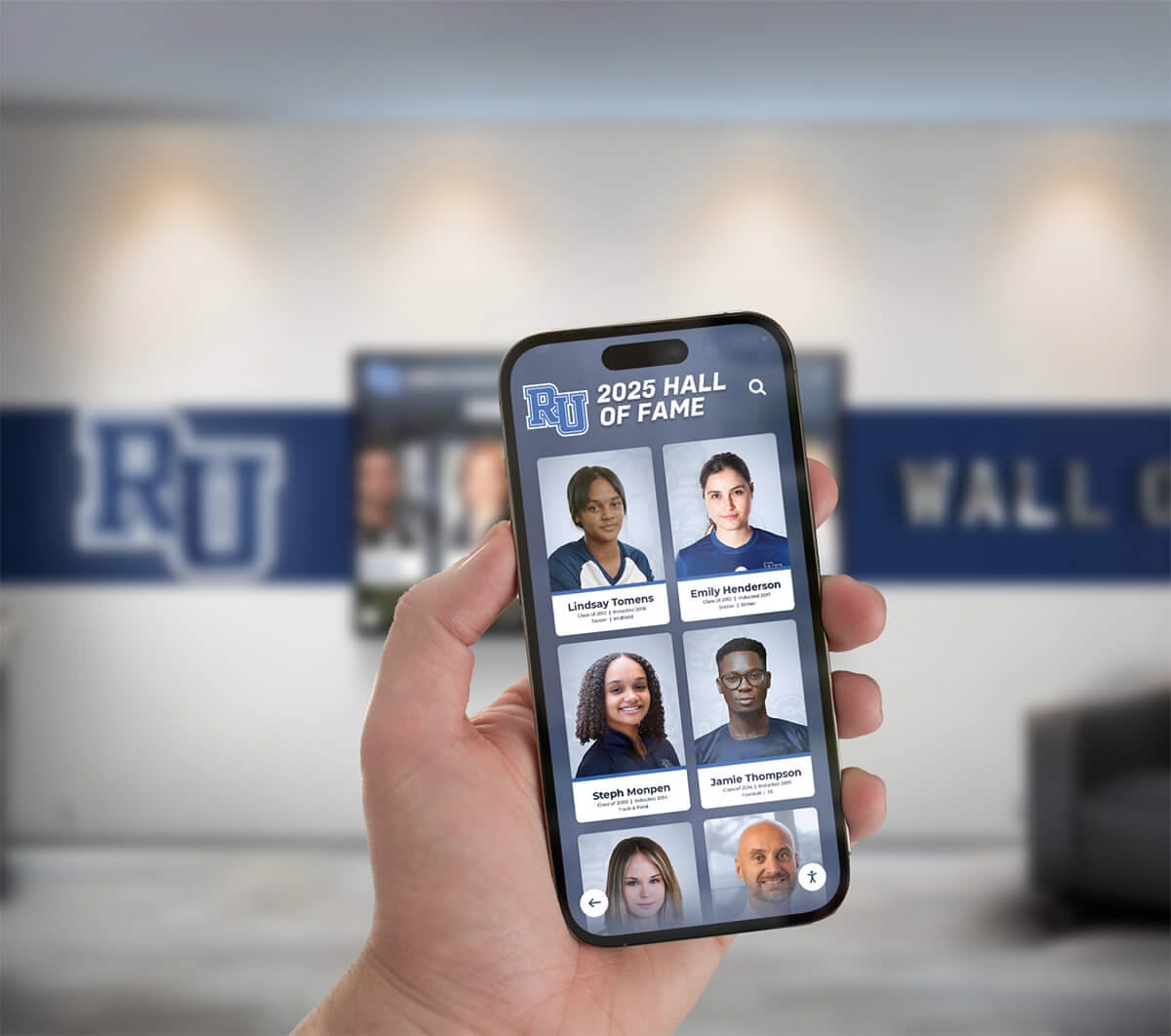
Impact Demonstration
Effective recognition goes beyond acknowledging gifts to demonstrating tangible outcomes donations enable. Digital displays can showcase:
- Scholarship recipients whose education became possible through donor support
- Research breakthroughs funded by philanthropic investment
- Facilities enabling enhanced learning experiences
- Programs serving community needs through donor generosity
- Student success stories directly attributable to donor-funded resources
This impact documentation satisfies donor desire to see their contributions create meaningful change, strengthening emotional connections and encouraging continued support.
For frameworks on developing compelling narratives, review resources on storytelling through digital recognition.
Interactive Engagement Deepens Donor Connections
Passive viewing of traditional displays creates limited engagement. Interactive digital systems invite active exploration that deepens donor connections through hands-on participation.
Search and Discovery Features
Interactive touchscreen displays enable visitors to:
- Search for their own names and immediately see their recognition
- Browse by giving society, graduation class, or recognition category
- Filter by campaign designation or fund supported
- Explore geographic distribution of donor community
- View timeline displays showing giving history across years
This self-directed exploration creates personal engagement that passive viewing cannot match. Donors finding themselves recognized experience satisfaction and validation, while prospective donors discover giving opportunities through browsing.
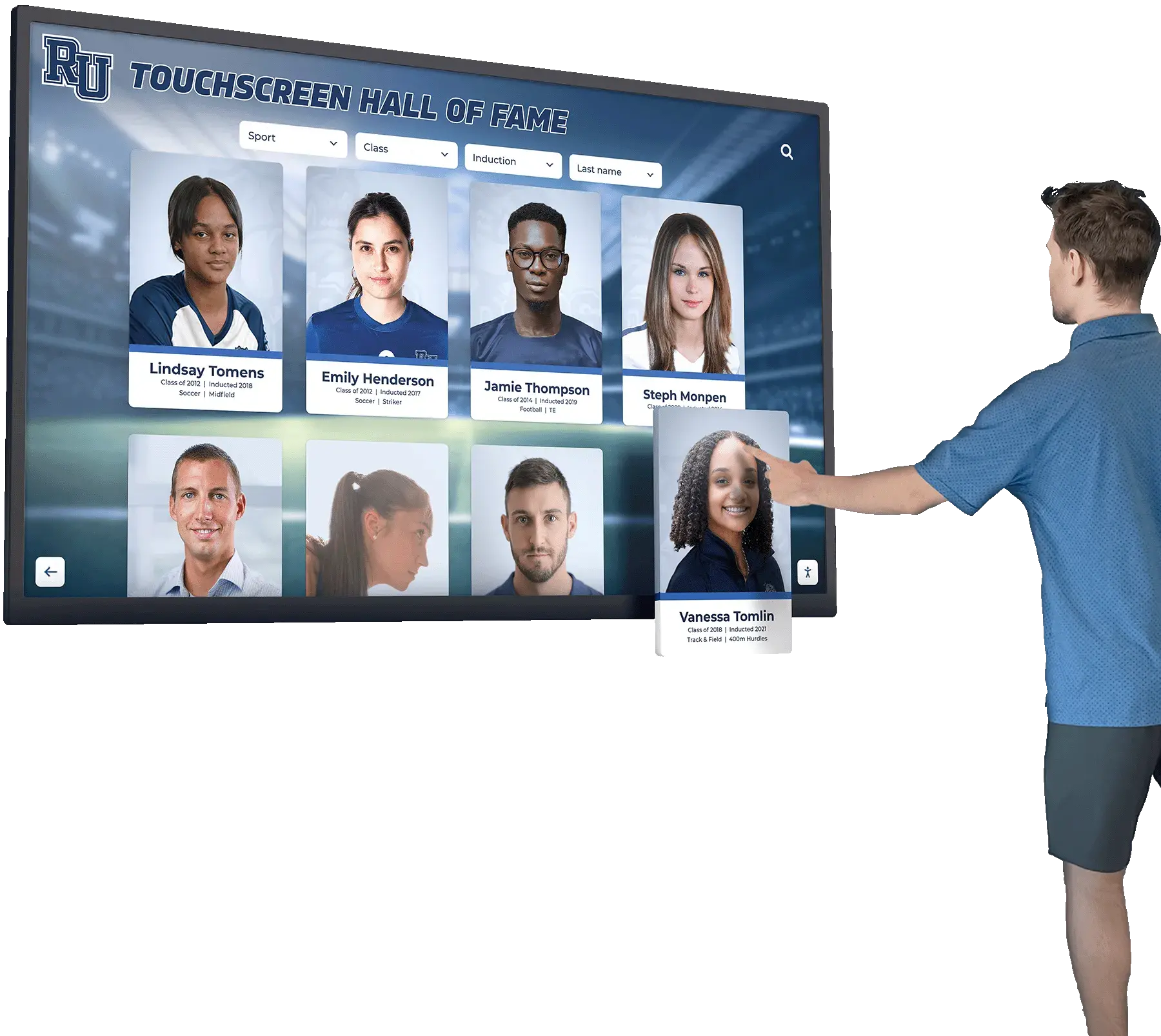
Social Sharing Capabilities
Digital content is inherently shareable, extending recognition reach far beyond physical campus locations. Donors can:
- Photograph recognition displays and share on social media
- Access online companion websites from anywhere globally
- Share direct links to their recognition profiles with family and networks
- Download certificates or digital recognition materials
- Tag institutions in social media posts amplifying visibility
This organic sharing creates marketing value while providing donors easy ways to celebrate their philanthropy with personal networks, further strengthening institutional connections.
Real-Time Updates Demonstrate Active Stewardship
Traditional displays require vendor coordination, engraving timelines, and installation scheduling that delay recognition by weeks or months. Digital systems enable immediate updates that demonstrate responsive stewardship.
Timely Recognition Benefits
When colleges add donors to recognition displays within days of gift confirmation:
- Donors experience timely appreciation that reinforces positive giving decisions
- Recognition appears while donor enthusiasm remains high
- Institutions demonstrate efficiency and respect for supporters
- Momentum builds visibly during active fundraising campaigns
- Social proof accumulates rapidly encouraging additional participation
Research from advancement professionals confirms that recognition timing significantly impacts donor satisfaction and retention. Immediate acknowledgment creates stronger positive associations than delayed recognition, directly influencing likelihood of continued support.
Campaign Progress Visualization
During active fundraising campaigns, digital displays can show real-time progress through:
- Thermometer-style progress bars updating daily
- Recognition of recent gifts appearing immediately after processing
- Countdown timers for campaign deadlines creating urgency
- Leaderboards fostering friendly competition between classes
- Milestone celebrations when goals are reached
This transparency and immediacy maintains donor engagement throughout multi-year campaigns, not just at launch and conclusion. Visible momentum encourages participation from prospects who want to join successful initiatives.
For comprehensive campaign support strategies, explore guides on interactive advancement solutions.
Strategic Implementation for Maximum Engagement Impact
Understanding benefits is valuable, but successful implementation requires systematic approaches that maximize donor engagement outcomes from recognition investments.
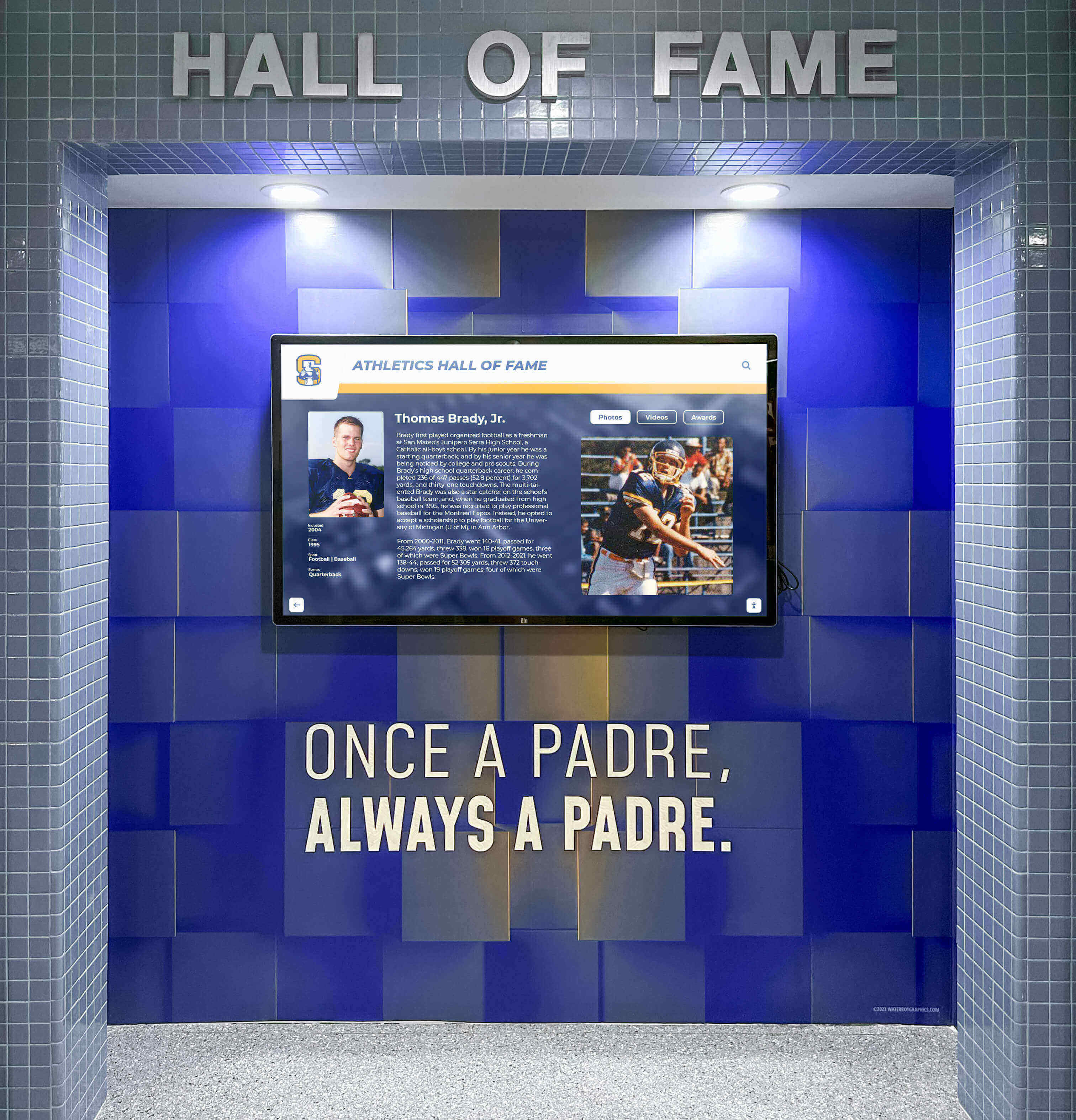
Designing Recognition Frameworks That Drive Engagement
Effective recognition structures balance comprehensive inclusion with clear differentiation between giving levels, creating pathways that motivate both initial participation and gift progression.
Giving Society Architecture
Thoughtful society structures ensure all contributors feel appropriately valued while communicating clear progression opportunities:
| Society Level | Cumulative Giving | Recognition Benefits | Engagement Impact |
|---|---|---|---|
| Visionary Circle | $1,000,000+ | Comprehensive multimedia profiles, traditional plaque, premium event access | Honors transformational commitments inspiring similar leadership |
| Heritage Society | $500,000-$999,999 | Featured video testimonials, enhanced biographical content, leadership council membership | Creates aspiration for major gift prospects, validates significant investments |
| Leadership Circle | $250,000-$499,999 | Extended profiles with photos and stories, special recognition events | Motivates mid-level donor progression to major gift status |
| President's Society | $100,000-$249,999 | Biographical recognition, impact documentation, exclusive previews | Demonstrates clear pathway from annual giving to major support |
| Dean's Circle | $50,000-$99,999 | Donor profiles with personal statements, society member directory | Recognizes sustained commitment encouraging continued progression |
| Benefactor's Club | $25,000-$49,999 | Name recognition with graduation year and giving level | Provides initial major gift recognition inspiring further growth |
| Patron's Society | $10,000-$24,999 | Comprehensive digital recognition, annual fund leadership acknowledgment | Bridges annual giving to major gift threshold |
Recognition thresholds should reflect institutional scale and donor capacity. Small liberal arts colleges might establish top tiers at $250,000 while research universities set thresholds at $5,000,000 for highest recognition levels.
Annual Giving Integration
Complementary annual recognition acknowledges consistent yearly support alongside cumulative lifetime giving:
- Consecutive giving clubs (5, 10, 25+ years of continuous contributions)
- Leadership annual fund levels (top annual gifts each fiscal year)
- Young alumni societies establishing lifelong giving patterns
- Reunion giving competitions fostering class-based participation
- Faculty and staff giving recognition encouraging campus community support
Creating multiple recognition pathways ensures advancement teams can cultivate donors through various approaches while celebrating all forms of institutional support meaningfully.
Content Strategies That Sustain Engagement
Initial recognition launch creates excitement, but sustained engagement requires ongoing content development and regular updates that keep displays fresh and relevant.
Update Cadence for Continuous Engagement
Quarterly Major Updates:
- Add new donor cohorts meeting recognition thresholds
- Launch new campaign-specific recognition sections
- Expand biographical profiles with additional content
- Refresh design themes maintaining contemporary appearance
- Feature anniversary recognition for significant milestones
Monthly Content Rotation:
- Rotate featured donor spotlights on home screens
- Update campaign progress visualization and metrics
- Add recent event photos and highlights
- Promote upcoming advancement events and programs
- Showcase new impact stories and beneficiary testimonials
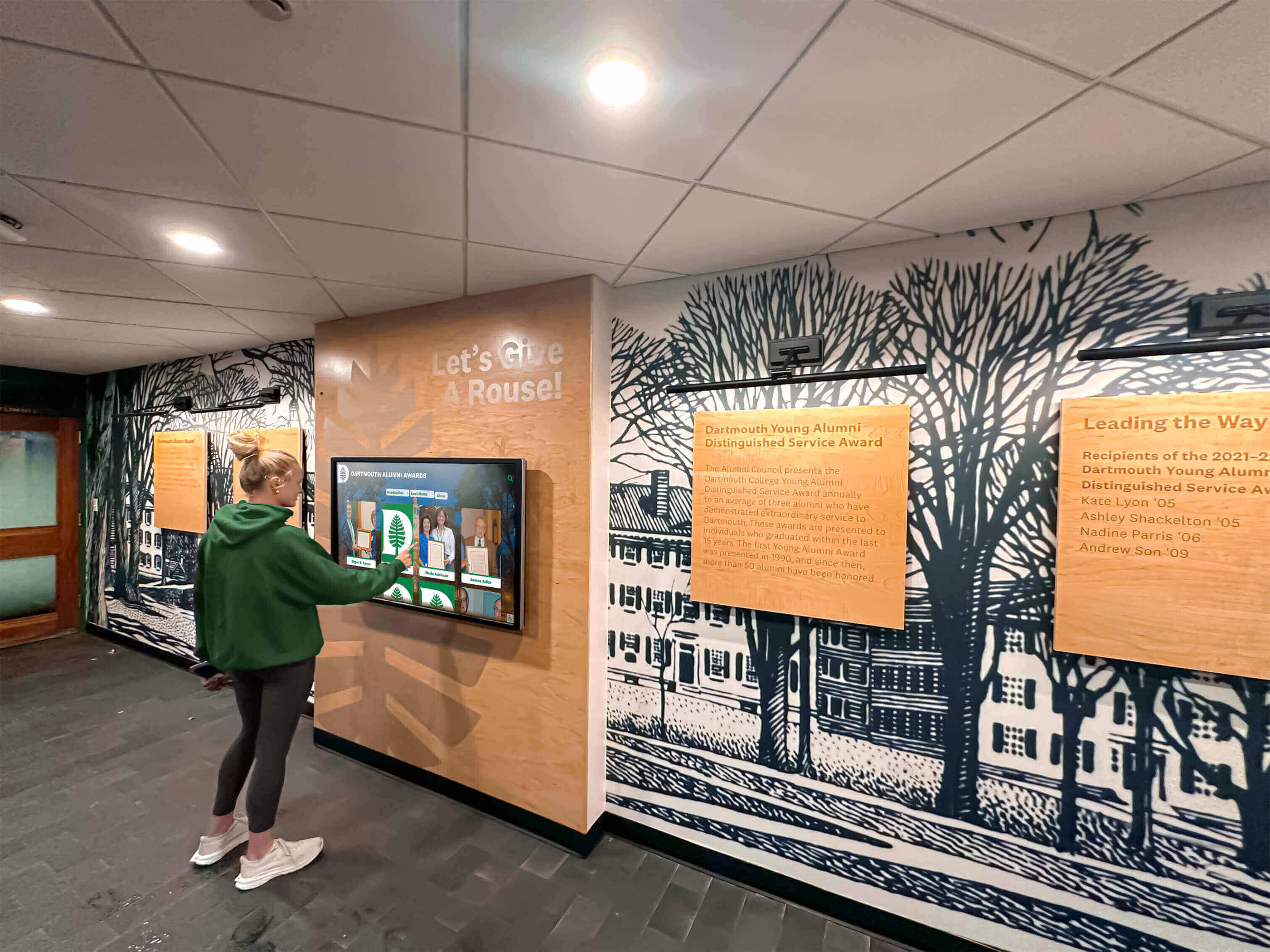
Weekly Engagement Activities:
- Add newly confirmed donors immediately after gift processing
- Share recognition content on social media channels
- Monitor analytics identifying high-performing content
- Respond to donor inquiries and feedback
- Test functionality ensuring optimal operation
Content Quality Standards
Maintaining professional standards ensures recognition appropriately honors supporters:
- Professional photography or high-resolution images
- Well-written, carefully edited biographical content
- Compelling storytelling focusing on impact and motivation
- Consistent formatting and structure across all profiles
- Thorough fact-checking and verification before publishing
- Donor review and approval for enhanced content
- Regular content audits identifying improvement opportunities
Teams implementing sophisticated content strategies report significantly higher engagement and institutional impact, maximizing value delivered by recognition investments.
Location and Accessibility Strategies
Strategic placement and multi-channel access maximize donor engagement by ensuring recognition reaches supporters wherever they connect with institutions.
Physical Display Placement
High-traffic campus locations ensure maximum visibility:
- Main entrance lobbies welcoming all campus visitors
- Development office waiting areas where donor meetings occur
- Alumni center gathering spaces hosting events and programs
- Athletic facilities during games and competitions
- Student unions and campus centers with constant foot traffic
- Library entrances serving academic communities
- Special event venues used for advancement gatherings
Contextual placement near spaces directly impacted by donations—outside renovated facilities, in scholarship student areas, adjacent to research labs—creates visual connections between generosity and tangible outcomes.
Online Extension
Web-based recognition platforms extend appreciation beyond physical locations:
- Dedicated donor recognition websites accessible globally
- Integration within institutional advancement web pages
- Mobile-responsive design enabling smartphone access
- Social media sharing features amplifying reach
- Email newsletter integration promoting recognition regularly
- Embedded displays in virtual tour experiences
- Connection to online giving forms enabling immediate participation
For comprehensive approaches to digital engagement, explore resources on digital hall of fame planning.
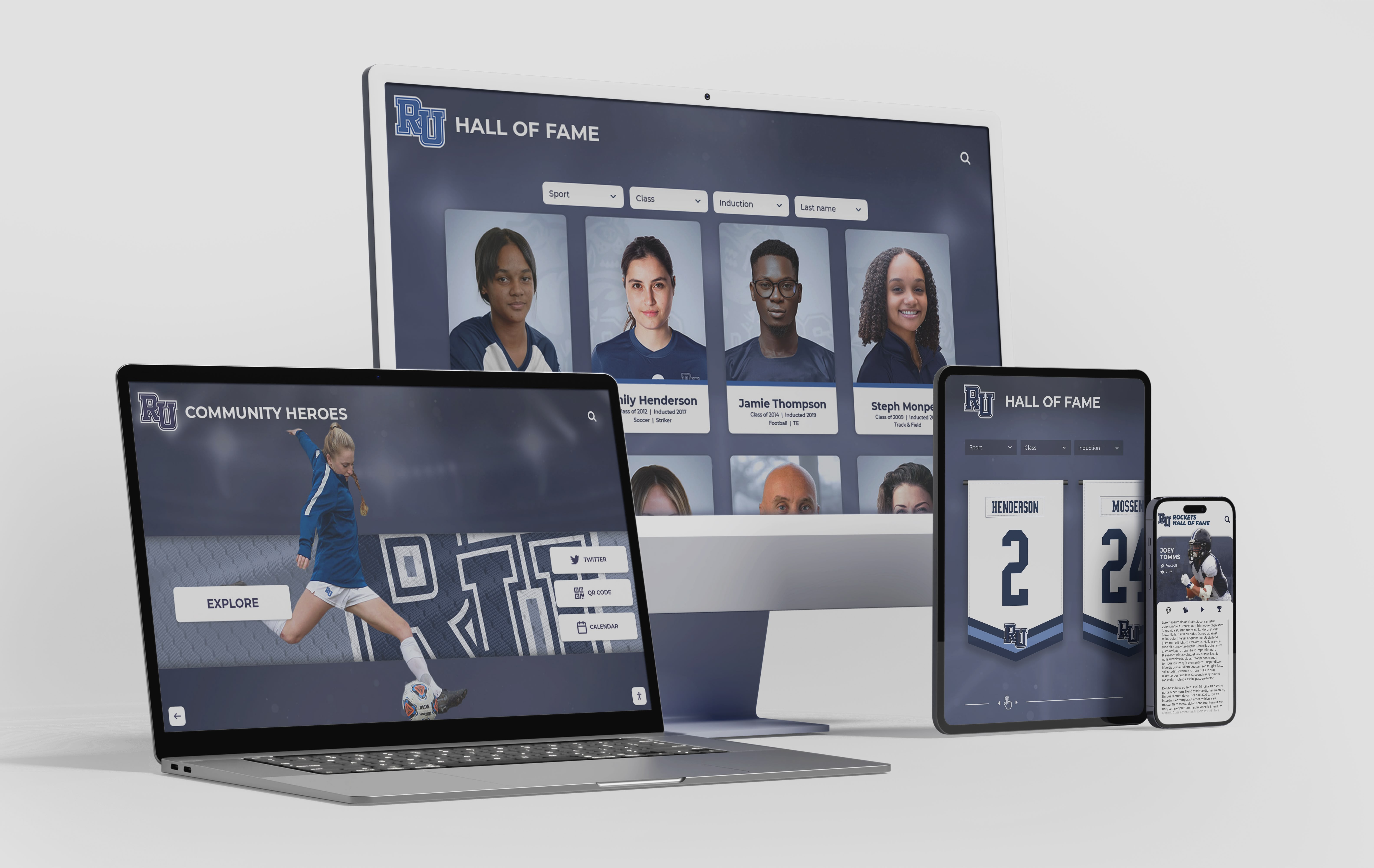
Measuring Engagement Impact and Demonstrating ROI
Advancement leadership requires evidence that recognition investments deliver returns justifying resources allocated. Comprehensive measurement demonstrates both engagement outcomes and financial value.
Key Engagement Metrics
Interaction Analytics
Digital recognition systems provide detailed engagement data impossible with traditional displays:
- Total interactions and unique visitors to displays
- Session duration showing depth of engagement
- Repeat visitor rates indicating sustained interest
- Most viewed profiles and content identifying what resonates
- Search queries revealing visitor interests and intentions
- Navigation patterns showing exploration behavior
- Peak usage times informing optimal update schedules
- Content performance metrics comparing formats
These quantitative metrics provide objective evidence of recognition program effectiveness and enable data-driven optimization of content strategies.
Donor Behavior Outcomes
Connect recognition engagement to advancement outcomes demonstrating direct value:
Retention Impact
- Retention rates of recognized donors versus unrecognized supporters
- Multi-year giving patterns among recognized donors
- Time to next gift for recognized versus unrecognized donors
- Lapsed donor reactivation rates after recognition
Gift Progression
- Upgrade rates showing donors increasing giving levels
- Average gift size changes following recognition
- Time from initial gift to major gift conversion
- Planned giving inquiry rates from long-term recognized supporters
Acquisition Effects
- New donor acquisition rates during recognition campaign periods
- Referral rates from recognized donors
- First-time donor conversion to sustained giving
- Campaign participation rates before and after recognition
While isolating recognition impact from broader advancement factors presents challenges, institutions tracking these metrics typically demonstrate positive correlations between quality recognition and improved fundraising outcomes.
Return on Investment Analysis
Comprehensive ROI calculation includes both direct cost savings and engagement value delivered.
Cost Comparison Framework
Traditional Recognition Costs (10-Year Projection)
Assuming 50 new donors annually at average institution:
- Initial donor wall installation: $15,000-$30,000
- Ongoing plaque costs: $200-$500 × 500 donors = $100,000-$250,000
- Installation labor and coordination: $15,000-$30,000
- Space expansion when capacity reached: $20,000-$50,000
- Maintenance and replacement: $5,000-$10,000
- Total 10-year cost: $155,000-$370,000
Digital Recognition Investment (10-Year Projection)
- Initial hardware and software: $15,000-$45,000
- Annual software licensing and support: $3,000-$8,000 × 10 years = $30,000-$80,000
- Content development (absorbed in existing staff time)
- Maintenance and technical support (included in annual costs)
- Total 10-year cost: $45,000-$125,000
Net Savings: $110,000-$245,000 over 10 years
Plus unlimited capacity, instant updates, rich multimedia content, engagement analytics, and online accessibility impossible with traditional recognition.
Engagement Value Calculation
Beyond direct cost savings, quantify engagement benefits:
According to industry research, digital donor recognition delivers:
- 40-60% improvements in donor retention rates
- 18-24% increases in donor participation during first year
- 25-35% average gift size increases
- 3:1 to 6:1 ROI ratios depending on institutional maturity
For an institution with 1,000 active donors averaging $500 annual gifts:
- 10% retention improvement = 100 additional retained donors
- Additional annual revenue from retention: 100 donors × $500 = $50,000
- Over 10 years: $500,000 in additional retained giving
- ROI: $500,000 additional revenue ÷ $45,000-$125,000 investment = 4:1 to 11:1 return
This simplified analysis excludes additional benefits like gift upgrades, new donor acquisition, volunteer engagement, and strategic value of analytics and storytelling capabilities.
For detailed ROI analysis methodologies, review comprehensive guides on measuring digital recognition success.
Best Practices from Successful College Advancement Programs
Leading institutions implementing digital donor recognition share common approaches that maximize engagement impact and advancement outcomes.
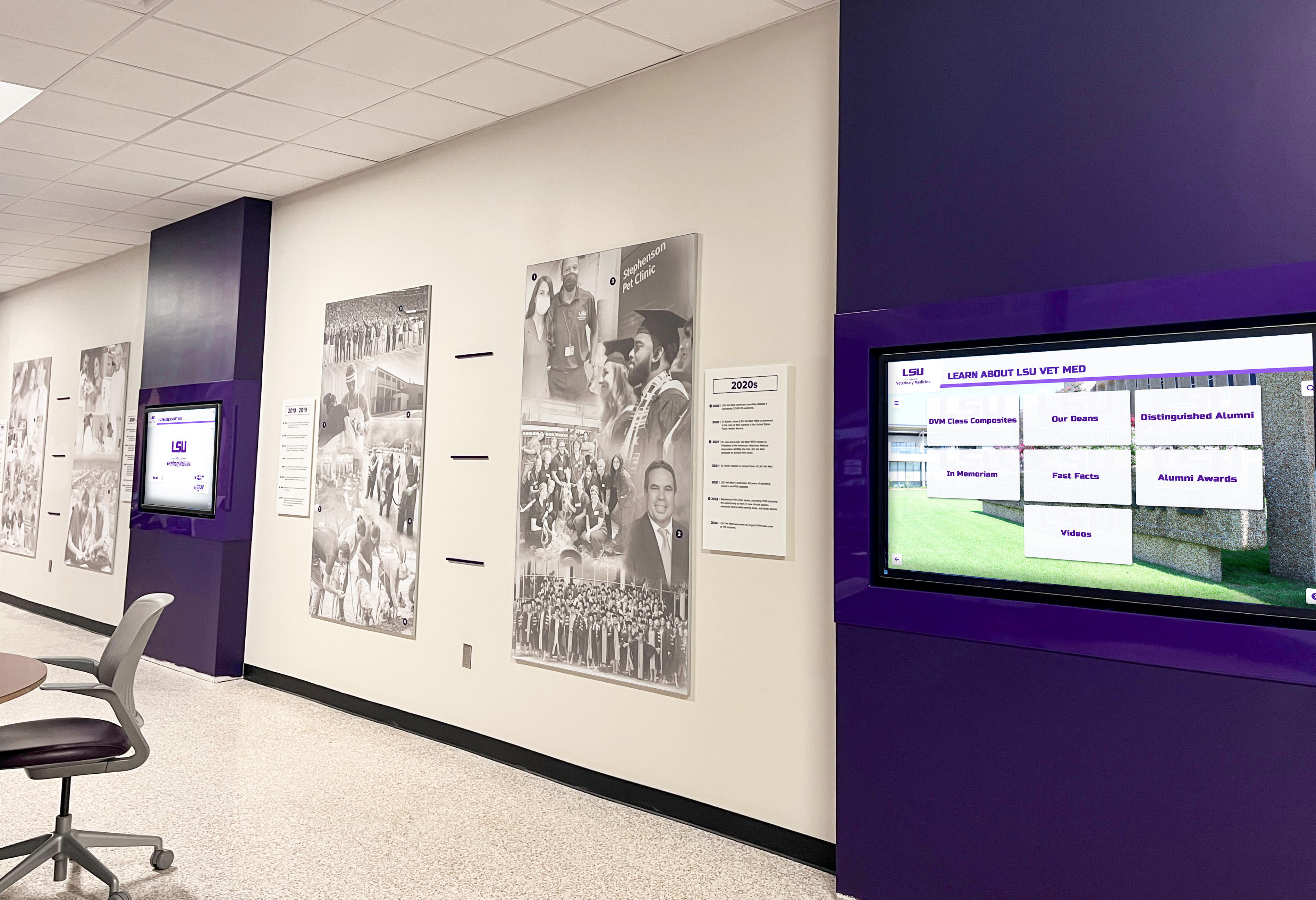
Privacy and Personalization Balance
Effective recognition respects donor preferences while providing meaningful public acknowledgment.
Granular Privacy Controls
Survey donors about recognition preferences before public display:
- Preferred name format (full name, initials, family name, anonymous)
- Photo permission and image selection approval
- Comfort level with gift amount versus giving level category display
- Story sharing authorization and content review approval
- Contact information inclusion preferences
- Future communication opt-in/opt-out choices
Respecting privacy preferences builds trust while preventing uncomfortable situations that could damage donor relationships. Provide easy methods for donors to update preferences as comfort levels evolve.
Anonymous Recognition Options
Honor anonymous preferences while maintaining social proof:
- List number of anonymous donors at each giving level
- Create “Anonymous Donor” listings showing support volume without identification
- Develop separate private recognition experiences for donors declining public acknowledgment
- Offer alternative stewardship touchpoints through personal communication
- Respect anonymous requests absolutely without pressure for visibility
Integration Throughout Advancement Strategy
Digital recognition delivers maximum engagement when integrated across advancement operations rather than existing as standalone initiative.
Fundraising Integration
- Feature recognition prominently in campaign case statements and materials
- Include recognition preview as cultivation tool during major gift proposals
- Coordinate unveiling ceremonies with campaign milestones and events
- Integrate recognition benefits into giving society membership packages
- Use engagement analytics to inform solicitation strategy and timing
Alumni Relations Integration
- Incorporate recognition content throughout alumni website
- Develop signature events around recognition induction ceremonies
- Train all advancement staff to reference displays during interactions
- Create recognition-focused social media campaigns
- Measure recognition impact on broader alumni engagement metrics
Event Integration
- Position displays prominently at homecoming, reunions, and galas
- Create programming around recognition unveiling and induction
- Use displays as information centers during large gatherings
- Capture event content and photos for addition to recognition displays
- Promote upcoming events through recognition platform messaging
Understanding how recognition integrates with comprehensive strategies helps institutions maximize value. Explore resources on college recruitment and digital recognition programs for additional integration approaches.
Continuous Improvement Through Analytics
Data-driven optimization ensures recognition programs evolve to maximize engagement over time.
Regular Analysis Practices
- Monthly dashboard reviews identifying trends and patterns
- Quarterly deep analyses examining content performance comprehensively
- A/B testing different content formats and presentation approaches
- Benchmarking current periods against historical performance
- Comparative analysis across multiple display locations when applicable
Optimization Actions
Based on analytics insights:
- Expand content types generating highest engagement
- Improve or remove low-performing content consuming resources
- Optimize featured content based on viewing patterns and duration
- Adjust update schedules to match peak usage times
- Invest resources in formats delivering strongest results
- Refine search functionality based on query patterns
- Enhance navigation based on behavior flow analysis
Stakeholder Communication
Share results demonstrating value:
- Regular reports to leadership showing usage and engagement metrics
- Success stories highlighting specific donor outcomes
- ROI calculations connecting recognition to fundraising results
- Donor testimonials and qualitative feedback
- Recommendations for continued investment and expansion
Overcoming Common Implementation Challenges
Even well-planned recognition programs encounter predictable obstacles. Anticipating challenges enables proactive solutions that preserve engagement impact.
Challenge: Budget Constraints and Competing Priorities
Advancement offices face competing demands for limited resources, making recognition investments difficult to justify alongside immediate fundraising needs.
Solutions:
- Calculate long-term cost savings of digital systems versus traditional approaches
- Present comprehensive ROI analysis including retention and engagement benefits
- Explore donor sponsorship specifically for recognition technology
- Phase implementation starting with one display and expanding over time
- Include recognition infrastructure in comprehensive campaign budgets
- Partner with facilities or IT departments sharing technology costs
Challenge: Content Gathering and Management Complexity
Collecting biographical information, photos, and personal statements from hundreds or thousands of donors requires significant effort advancement teams struggle to find time for.
Solutions:
- Start with major donors and expand gradually to broader donor populations
- Leverage existing advancement database information as content foundation
- Invite donors to submit content through online forms and self-service portals
- Accept that initial implementation may feature basic profiles enhanced over time
- Partner with alumni relations accessing their photograph archives and biographical files
- Build content collection into stewardship workflows for all new major gifts
- Consider outsourcing initial content development to accelerate launch
Challenge: Stakeholder Concerns About Technology
Traditional donors, board members, or institutional leaders may prefer familiar physical plaques over digital innovations or question reliability of technology.
Solutions:
- Emphasize that digital recognition supplements rather than replaces appropriate traditional elements
- Create hybrid approaches featuring physical recognition for top giving tiers alongside comprehensive digital databases
- Provide demonstrations showing engaging capabilities unavailable with traditional recognition
- Share success stories and references from peer institutions with similar constituencies
- Frame digital recognition as honoring tradition through contemporary methods
- Calculate and communicate long-term cost savings enabling increased program funding
- Address reliability concerns through commercial-grade hardware and comprehensive support
For guidance on avoiding common pitfalls, review resources on common mistakes installing recognition boards.
The Future of College Donor Recognition and Engagement
Recognition technology and donor expectations continue evolving. Forward-thinking institutions position themselves for emerging trends that will shape next decade of advancement.
Emerging Technologies
Artificial Intelligence and Personalization
AI-powered recognition systems will enable:
- Natural language search supporting conversational donor discovery
- Personalized content recommendations based on visitor demographics and relationships
- Automated impact reporting connecting individual gifts to specific institutional outcomes
- Predictive analytics identifying optimal recognition timing and formats for individual donors
- Enhanced data integration pulling information from multiple institutional systems automatically
Mobile Integration and Augmented Reality
Expanded mobile capabilities will include:
- Comprehensive campus-wide recognition accessible anywhere via smartphones
- Augmented reality overlays providing enhanced information when viewing physical displays through mobile devices
- Location-based notifications alerting visitors to nearby recognition opportunities during campus visits
- Offline access enabling content viewing without internet connectivity
- Social integration facilitating recognition sharing across personal networks
Enhanced Analytics and Optimization
Sophisticated tracking will enable:
- A/B testing determining which content approaches generate strongest engagement outcomes
- Heat mapping showing attention patterns guiding design optimization
- Conversion tracking connecting recognition exposure to subsequent giving behavior
- Sentiment analysis of donor feedback informing content strategy
- Benchmark comparisons showing institutional performance relative to peer programs
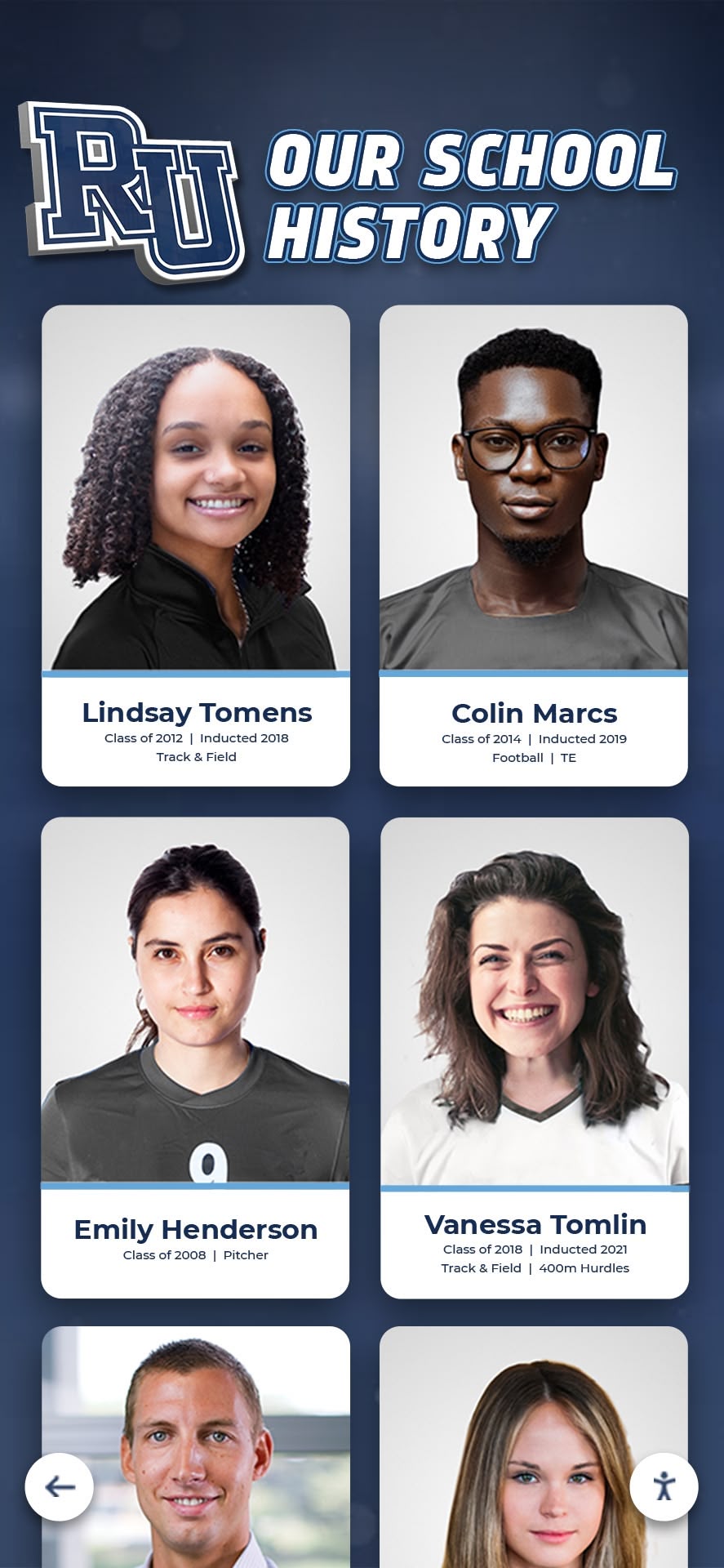
Evolving Donor Expectations
Generational shifts in donor populations will require recognition adaptation.
Younger Donor Preferences
Millennials and Gen Z donors increasingly expect:
- Digital-first experiences with mobile accessibility
- Immediate recognition and gratitude without lengthy delays
- Transparent impact documentation showing exactly how gifts create change
- Interactive engagement opportunities beyond passive viewing
- Social sharing capabilities enabling celebration within personal networks
- Authentic storytelling focusing on real people and outcomes
Recognition programs addressing these preferences position institutions for sustained engagement with emerging donor generations who will drive philanthropic support for decades.
Integrated Digital Experiences
Future donor expectations will demand seamless integration across:
- Physical campus recognition displays
- Online recognition websites and portals
- Mobile applications providing on-demand access
- Social media presence amplifying recognition reach
- Email communications featuring recognition content
- Virtual reality experiences for remote donors
- Voice-activated discovery through smart assistants
Colleges investing in flexible recognition platforms that evolve with technology and expectations gain significant advantages over institutions locked into static traditional approaches.
Conclusion: Recognition as Strategic Engagement Driver
Declining donor retention rates and intensifying competition for philanthropic support have transformed effective recognition from courtesy to strategic imperative for college advancement. Modern digital recognition systems provide powerful tools enabling institutions to increase donor engagement, improve retention rates, and drive measurable fundraising success through meaningful appreciation that goes beyond traditional name plaques.
The most successful implementations share common characteristics: they recognize donors at all giving levels inclusively, tell compelling stories connecting generosity to institutional impact, provide interactive engagement through multiple formats and channels, maintain accuracy and currency through efficient administration, and demonstrate measurable advancement outcomes justifying continued investment.
Solutions like Rocket Alumni Solutions enable colleges to implement comprehensive recognition programs that honor every contribution meaningfully while eliminating arbitrary capacity constraints that previously forced difficult exclusions. By providing unlimited recognition capacity, instant updates, rich multimedia storytelling, interactive engagement features, and detailed analytics, digital platforms transform recognition from administrative obligation into strategic advancement asset.
As donor expectations continue evolving and competition for philanthropic support intensifies, colleges that invest in recognition technology positioning them for sustained engagement gain significant advantages. Every supporter who invests financially in educational missions deserves recognition honoring both their generosity and the impact it enables. Digital recognition systems that accomplish this dual purpose while inspiring future giving create value extending far beyond initial investments, supporting institutional advancement for generations to come.
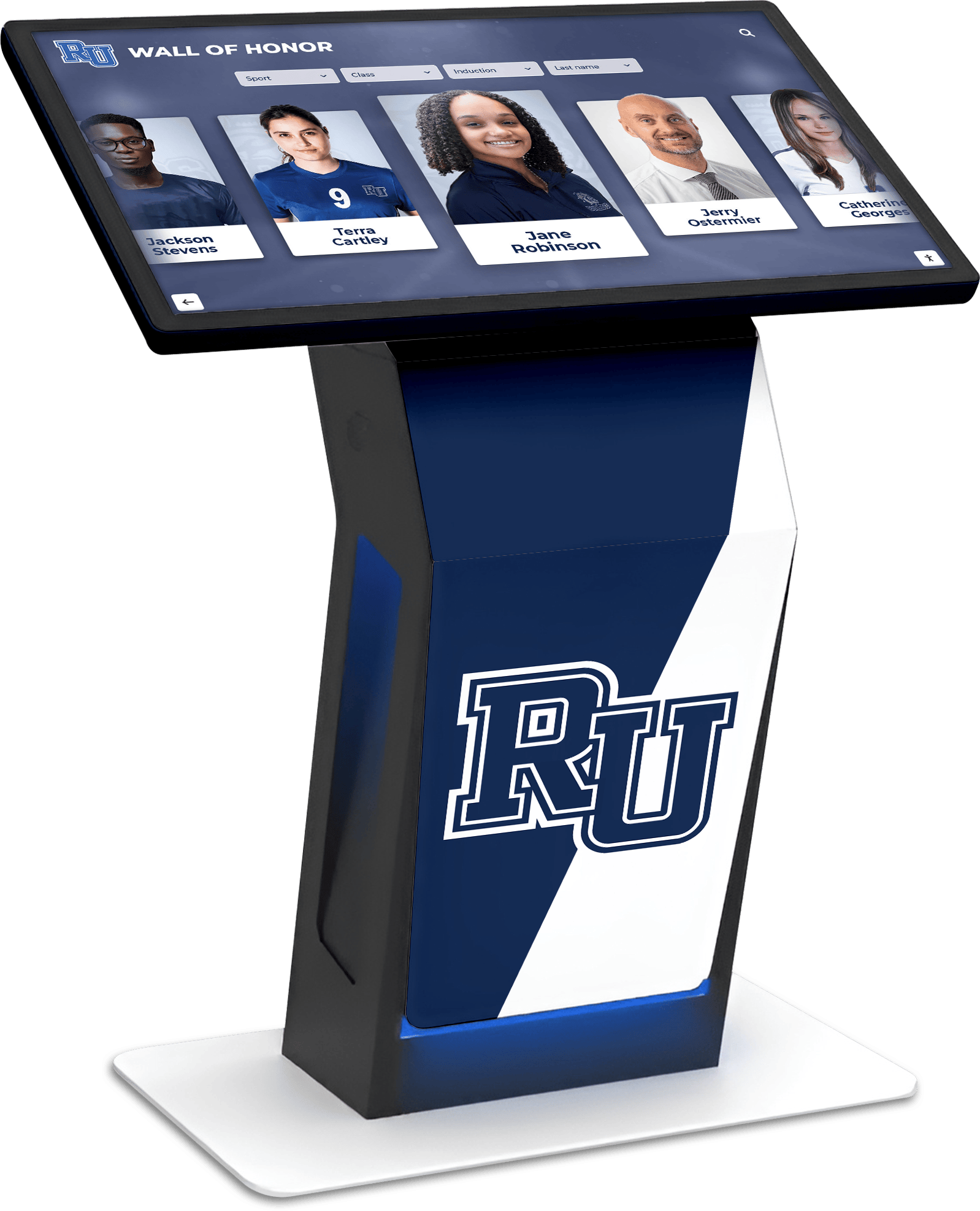
For advancement professionals seeking recognition solutions that deliver measurable engagement impact, exploring Rocket Alumni Solutions provides pathway to implementing proven technology that transforms donor relationships and advances institutional missions through meaningful appreciation at scale.
